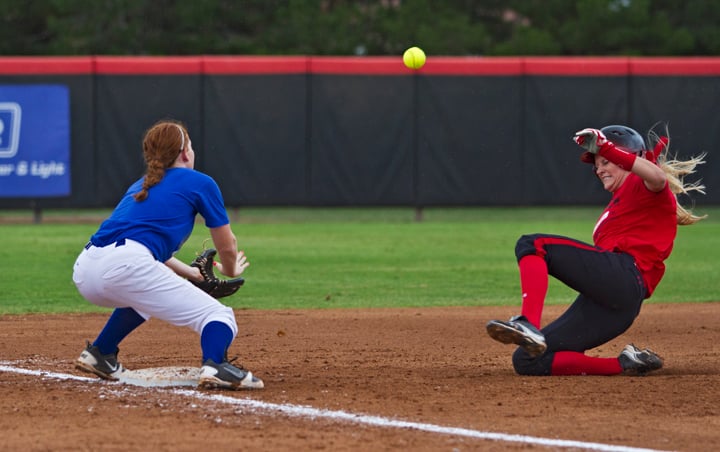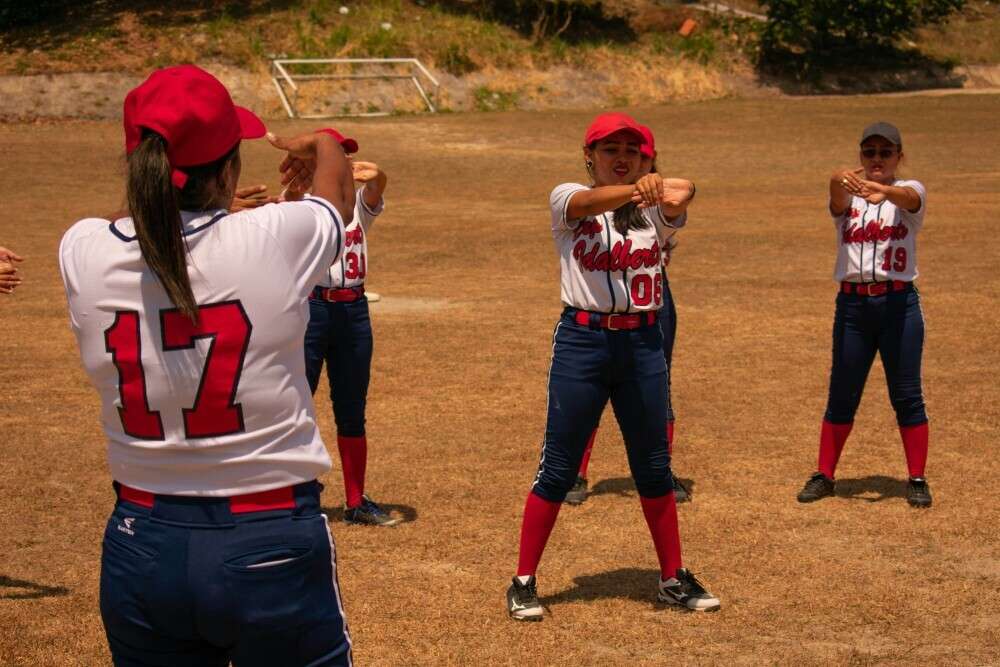
Softball players know the importance of keeping your eye on the ball. Whether you’re at the plate ready to bat or in the field prepped to make a catch, your eyes need to be just as well-trained as your body.
How you watch the ball can mean the difference between a home run and a disappointing ground ball that ends the inning in a double-play.
Train your eyes to watch the Ball
Start with the basics. Practice doesn’t just make perfect; it sharpens your visual focus. I recommend drills that mirror real game scenarios.
Track the ball from the moment it leaves their hand to when it hits the bat or lands in your glove.
Lighting conditions can wreak havoc on your ability to see the ball clearly.
Ever notice how a ball seems to vanish against the backdrop of a bright sky or under the lights at night?

The trick is to introduce visual acuity drills into your routine.
Use colored (yellow) softballs during practice. This not only enhances your visual acuity, it also prepares you for those tricky lighting conditions.
Timing is crucial. Your brain has to process the speed, angle, and the pitch type in a split second to make contact.
Invest time in rhythm and timing drills
In slowpitch softball, the pitch arc of the ball can range from 5-12 ft. This difference can change the speed of the ball as it approaches the batter.
Flat pitches, will move faster than high arcing pitches, and it is a good idea to learn how to successfully connect with any pitch. One tip is to watch the ball as it is released from the pitcher’s hand.
In slowpitch softball, as the batter, you must be patient and wait for the ball to reach you before you swing the bat and make contact.
With experience, you will learn where to hit certain pitches, low inside, high outside and down-the-middle pitches, they all have their places.
Before the rules changed, I was a right-handed batter that would hit foul balls down the 3rd base line to stay alive in the count.
Today, due to shortened game times, you might start with a 1 and 1 count. No longer can you hit foul balls without it being counted as a strike. That foul tip could get you called out.
Consistent practice with these cues will train your muscle memory and vision to work together. Remember, having a focused approach to visual tracking will significantly augment your ability to hit the ball effectively.
The Importance of Visually Tracking the Ball
Keeping your eye on the ball isn’t just a classic phrase; it’s critical advice that defines success in softball.
My focus today is on unpacking the value of visual tracking and how it shapes the way you catch, throw, and bat the softball, transforming your athletic performance.
You’ve likely noticed how the lighting conditions at different times of day impact your ability to see the ball.
During the day, the sun can create glare or cause the ball to blend into the bright sky. At night, artificial lights can create shadows or alter your depth perception.
These factors aren’t just inconveniences; they can be the difference between making a crucial catch or missing the ball entirely.
But what exactly makes hand-eye coordination so vital in softball?
Well, it’s the element that allows you to predict and react to the speed and trajectory of the ball.
Improved hand-eye coordination means you’re better equipped to hit that outside pitch or snag a line drive — essential skills on the diamond.
Through countless games and practices, you’ll find that the best players are those who’ve mastered the art of keeping their eye on the ball.
Let me share a few examples.
When a hitter tracks the ball from the pitcher’s hand all the way to the bat, they’re more likely to connect solidly.
A fielder who meticulously watches the ball into their glove has a higher chance of securing the out.
And a catcher’s precise focus unites the pitcher-catcher team, forming a bond that helps the pitcher to stay focused on delivering the best pitch.
In the next section, I’ll give you practical exercises that can sharpen your hand-eye coordination. These are tools that can help you adapt to challenging light conditions and make handling that fastball look easy.
Advanced Hand-Eye Coordination Exercises
I know firsthand that hand-eye coordination is the bedrock of a successful softball player. It’s the difference between smashing a home run and missing an easy pitch.

Coordination drills train your body and mind to work together flawlessly.
Quick, responsive movements stem from exercises that improve reaction time. A simple yet effective drill is the ball drop.
Here’s the setup: At the field, stand next to the bleachers, your teammate stands on a bench above you.
The goal is for them to drop a ball at any moment, and for you to catch the ball before it hits the ground. This improves split-second decision-making.
Balance Drills improve Throwing Skills
Balance is another critical component, often overlooked. When your body is balanced, your ability to track and react to the ball increases.
Balance exercises, like standing on one foot while playing catch, can be a game changer. Stand about 20 feet apart.
The goal is to successfully throw and catch the ball, back and forth, while standing on one foot. Throw 10 times, then switch to the other foot.
The benefits of these exercises don’t appear overnight, but consistent practice will show on the field.
It’s that daily commitment to improving your skills that separates a good player from a great one.
Don’t Take My Word for It
Ask other coaches, read interviews from top players, and watch games. You’ll see experts emphasizing hand-eye coordination time and again.
By integrating these drills into your routine, you can keep your eye on the game at the highest level.
The Final Out
Bottom line, with visual drills, your fielding and hitting skill levels will improve, and you will feel more confident about how you play the game.

2 thoughts on “Visual Tracking Drills For Softball Hitters”
Thanks, Dave, much appreciated.
Rudy
As a former high school coach in the 1970’s I was using many of these suggestions with great success.Thank you for sharing with others.